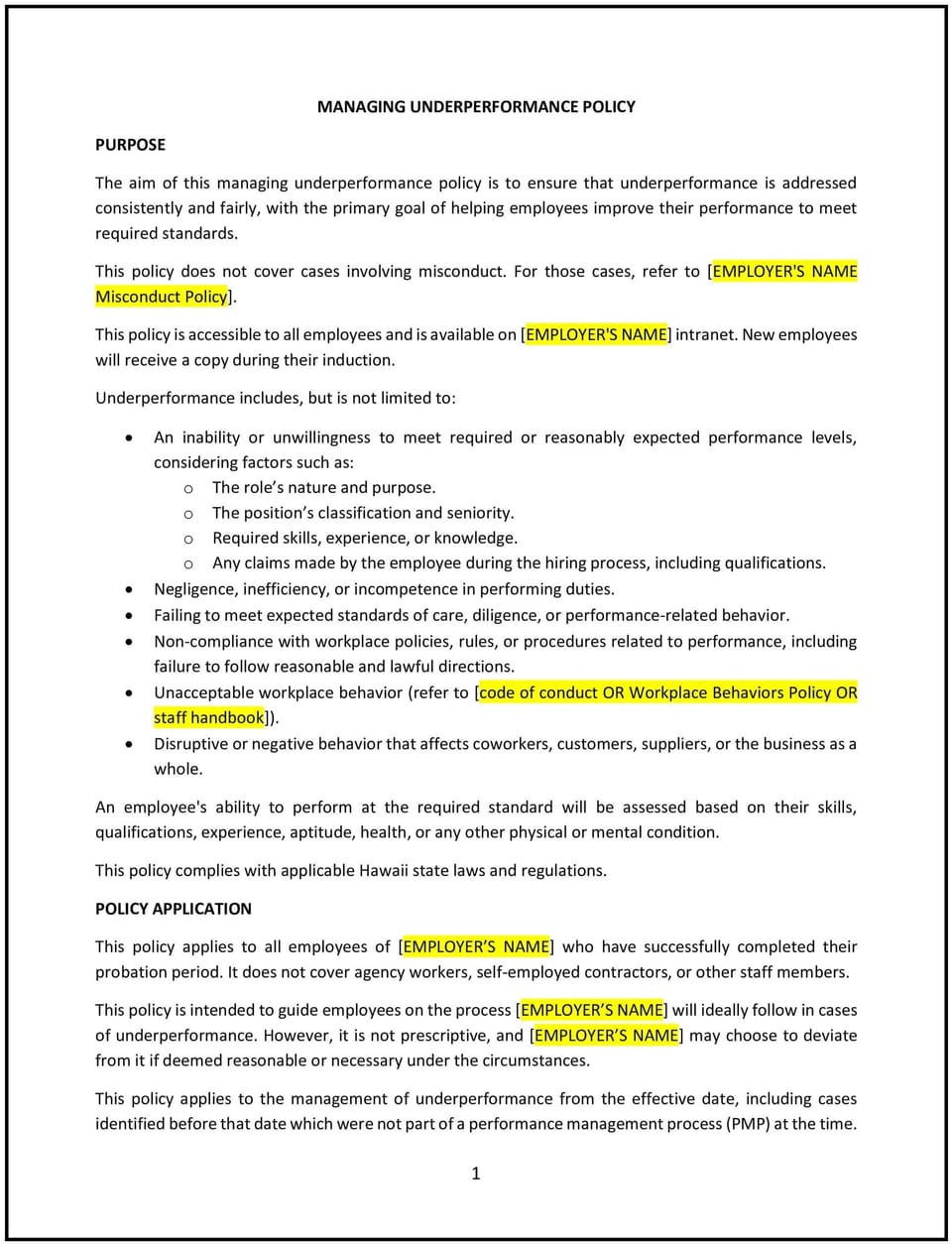Managing underperformance policy (Hawaiʻi): Free template

Managing underperformance policy (Hawaiʻi)
A managing underperformance policy helps Hawaiʻi businesses establish guidelines for addressing employee performance issues in a fair, constructive, and consistent manner. This policy outlines procedures for identifying, documenting, and improving underperformance, while addressing Hawaiʻi’s unique cultural and workplace dynamics. It is designed to support employees in meeting performance expectations and maintaining a productive work environment.
By implementing this policy, businesses in Hawaiʻi can improve employee performance, reduce turnover, and foster a culture of accountability and growth.
How to use this managing underperformance policy (Hawaiʻi)
- Define underperformance: Clearly outline what constitutes underperformance, such as failing to meet job expectations, missing deadlines, or exhibiting poor work quality.
- Establish performance standards: Provide clear expectations for employee performance, including job responsibilities, goals, and evaluation criteria.
- Create a performance improvement plan (PIP): Outline steps for developing a PIP, including setting specific, measurable goals, providing resources, and establishing timelines for improvement.
- Document performance issues: Require managers to document underperformance incidents, including dates, details, and actions taken, to ensure transparency and consistency.
- Provide feedback and support: Encourage regular feedback sessions between managers and employees to discuss progress, address challenges, and offer support.
- Communicate the policy: Share the policy with employees during onboarding and through internal communications to ensure awareness and understanding.
- Train managers: Educate supervisors on how to identify underperformance, conduct constructive feedback sessions, and implement performance improvement plans.
- Monitor progress: Regularly review employee performance and PIP progress to ensure improvement and address any ongoing issues.
- Review and update the policy: Regularly assess the policy’s effectiveness and make adjustments as needed to reflect changes in workplace dynamics or business needs.
Benefits of using this managing underperformance policy (Hawaiʻi)
This policy offers several advantages for Hawaiʻi businesses:
- Improves employee performance: A structured approach to addressing underperformance helps employees meet expectations and achieve their potential.
- Reduces turnover: Providing support and opportunities for improvement can increase employee satisfaction and retention.
- Promotes fairness: Clear procedures ensure underperformance is addressed consistently and transparently across the organization.
- Enhances workplace culture: A focus on growth and accountability fosters a positive and productive work environment.
- Aligns with legal standards: The policy helps businesses comply with Hawaiʻi state laws and federal regulations related to employee performance management.
- Encourages accountability: Employees understand their responsibilities for meeting performance standards and improving when necessary.
- Builds trust: A fair and supportive approach to managing underperformance demonstrates the business’s commitment to employee development.
Tips for using this managing underperformance policy (Hawaiʻi)
- Communicate the policy effectively: Share the policy with employees during onboarding and through regular reminders, such as emails or training sessions.
- Provide training: Educate managers on how to identify underperformance, conduct constructive feedback sessions, and implement performance improvement plans.
- Be consistent: Apply the policy uniformly to all employees to avoid perceptions of bias or favoritism.
- Offer support: Provide resources, such as training or mentorship, to help employees improve their performance.
- Monitor progress: Regularly review employee performance and PIP progress to ensure improvement and address any ongoing issues.
- Be transparent: Clearly explain the policy’s purpose, benefits, and expectations to employees to build trust and cooperation.
- Review the policy periodically: Update the policy as needed to reflect changes in workplace dynamics or business needs.
Q: Why should Hawaiʻi businesses adopt a managing underperformance policy?
A: Businesses should adopt this policy to improve employee performance, reduce turnover, and foster a culture of accountability and growth.
Q: What constitutes underperformance?
A: Underperformance may include failing to meet job expectations, missing deadlines, or exhibiting poor work quality, as defined in the policy.
Q: How should businesses address underperformance?
A: Businesses should follow structured procedures, such as creating a performance improvement plan (PIP), providing feedback, and offering support to help employees improve.
Q: What is a performance improvement plan (PIP)?
A: A PIP is a structured plan that outlines specific, measurable goals, timelines, and resources to help employees improve their performance.
Q: How should managers document underperformance?
A: Managers should document underperformance incidents, including dates, details, and actions taken, to ensure transparency and consistency.
Q: What training should businesses provide to managers?
A: Businesses should educate managers on how to identify underperformance, conduct constructive feedback sessions, and implement performance improvement plans.
Q: How often should the policy be reviewed?
A: The policy should be reviewed annually or as needed to reflect changes in workplace dynamics or business needs.
This article contains general legal information and does not contain legal advice. Cobrief is not a law firm or a substitute for an attorney or law firm. The law is complex and changes often. For legal advice, please ask a lawyer.


